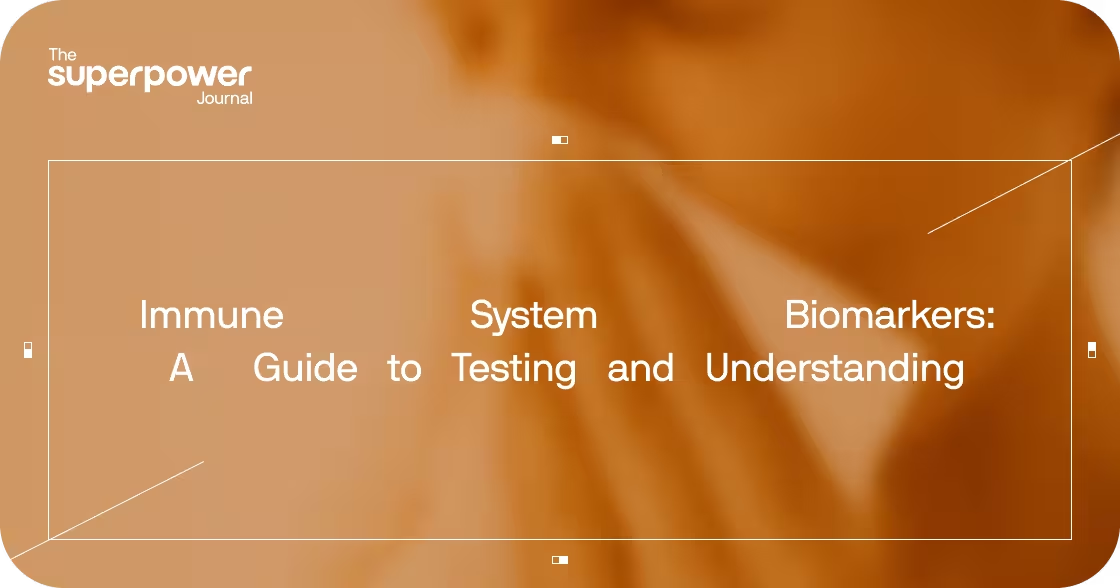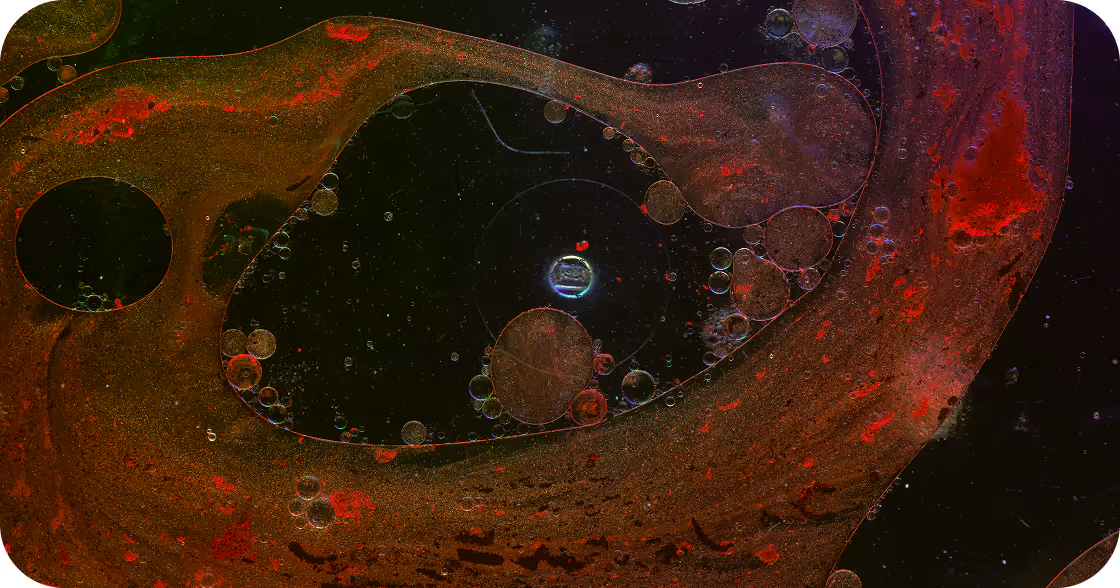Why Immune Dysfunction Matters
The immune system is central to maintaining long-term health. Dysregulated immune function contributes to a wide range of chronic diseases, including autoimmune disorders, cardiovascular disease, metabolic conditions, neurodegeneration, and age-related frailty¹ ². Research shows that low-grade, persistent inflammation — sometimes referred to as inflammaging — is a common underlying driver of many chronic illnesses and predicts earlier onset of disability and mortality³ ⁴.
The immune system is not only about defense against pathogens. It is a complex network of immune cells, signaling molecules, and barrier mechanisms that regulate processes like tissue repair, metabolic balance, and interaction with the nervous and endocrine systems⁵. Biomarkers that capture immune activity provide valuable insights into both acute and long-term health trajectories.
The Immune System as a Whole-Body Network
Immune activity influences virtually every organ system. Key points of interaction include:
- Metabolism: Pro-inflammatory cytokines such as tumor necrosis factor-alpha (TNF-α) and interleukin-6 (IL-6) interfere with insulin signaling and lipid metabolism, contributing to metabolic syndrome and type 2 diabetes⁶.
- Cardiovascular health: Chronic systemic inflammation destabilizes atherosclerotic plaques and raises risk for heart attacks and strokes⁷.
- Neurology: Microglial activation and circulating cytokines are linked to cognitive decline, depression, and risk for neurodegenerative disorders⁸ ⁹.
- Gut health: A large proportion of immune cells reside in the gastrointestinal tract, where diet and the microbiome shape immune function and inflammation¹⁰.
Because of these interactions, abnormal immune biomarkers rarely represent an isolated issue. Instead, they reflect broader system-wide shifts in physiology.
Innate vs. Adaptive Immunity: Biomarker Perspectives
The immune system has two major branches with distinct but complementary biomarkers:
- Innate immunity: The first line of defense, involving neutrophils, macrophages, natural killer (NK) cells, and acute-phase proteins such as C-reactive protein (CRP). Biomarkers here reflect immediate, nonspecific responses to infection or injury¹¹.
- Adaptive immunity: The slower, highly specific defense involving T cells, B cells, and antibodies. Biomarkers include CD4/CD8 ratios, immunoglobulin levels, and disease-specific autoantibodies such as thyroid peroxidase (TPO) antibodies or antinuclear antibodies (ANA)¹².
Monitoring both branches provides a comprehensive view: one patient may present with high CRP despite normal antibody titers, while another may show abnormal CD4/CD8 ratios indicating impaired adaptive immunity.
What Are Immune System Biomarkers?
Immune biomarkers are measurable signals — found in blood, saliva, stool, urine, or tissues — that reflect immune activity and balance. They can identify:
- Defense responses (e.g., white blood cell count during infection).
- Inflammatory signaling (e.g., CRP, IL-6, TNF-α).
- Autoimmunity (e.g., ANAs, rheumatoid factor, TPO antibodies).
- Immunosuppression or exhaustion (e.g., persistently low lymphocytes or impaired NK cell activity).
Unlike single diagnostic tests, immune biomarkers are dynamic, often providing early warning before overt disease develops¹³.
Key Immune System Biomarkers
Inflammatory Biomarkers
- C-reactive protein (CRP): Produced by the liver in response to IL-6, CRP is a sensitive and widely validated systemic inflammation marker. High-sensitivity CRP (hs-CRP) predicts cardiovascular risk even at low levels¹⁴.
- Erythrocyte sedimentation rate (ESR): A traditional inflammation marker, less specific but still used in autoimmune and chronic inflammatory conditions¹⁵.
- Interleukin-6 (IL-6): An upstream regulatory cytokine involved in both infection defense and chronic inflammation; elevated levels are linked to frailty, cardiovascular disease, and metabolic dysfunction¹⁶.
- Tumor necrosis factor-alpha (TNF-α): A master inflammatory cytokine central to autoimmune disease and insulin resistance¹⁷.
Cellular Biomarkers
- White blood cell (WBC) count & differential: Elevated neutrophils generally indicate infection or acute stress; lymphopenia (low lymphocyte counts) often signals immunosuppression or chronic illness¹⁸.
- CD4/CD8 ratio: A marker of adaptive immune balance. A low ratio is associated with immunosenescence and poor outcomes in aging, while very high ratios may indicate autoimmune activation¹⁹.
- Natural killer (NK) cell activity: Reflects innate immunity and plays roles in antiviral defense and cancer surveillance²⁰.
Autoimmunity Biomarkers
- Antinuclear antibodies (ANA): A general marker of autoimmunity, particularly connective tissue diseases²¹.
- Rheumatoid factor (RF) and anti-cyclic citrullinated peptide (anti-CCP) antibodies: Specific markers for rheumatoid arthritis²².
- Thyroid peroxidase antibodies (TPO-Ab): Strongly associated with autoimmune thyroid disease²³.
Metabolic-Immune Crosstalk Biomarkers
- Ferritin: An iron storage protein that is also an acute-phase reactant, often elevated in chronic inflammation²⁴.
- Homocysteine: A metabolic marker associated with cardiovascular and inflammatory risk²⁵.
- hs-CRP: Especially predictive of cardiometabolic outcomes²⁶.
Normal vs. Optimal Physiology
Standard lab ranges show population averages, but evidence suggests risks appear well within these “normal” ranges. For example, CRP levels above 2 mg/L substantially increase cardiovascular risk, despite being within “normal”²⁷. Similarly, IL-6 levels within the high-normal range predict frailty and disability²⁸.
Approximate ranges from research:
- CRP: <1 mg/L = low risk; 1–3 mg/L = moderate; >3 mg/L = high risk²⁹.
- IL-6: Low but detectable levels (<2 pg/mL) are considered lower risk; persistent levels above ~7 pg/mL are linked to frailty and mortality³⁰.
- CD4/CD8 ratio: Ratios below 1 indicate immunosenescence, while normal adult ranges are 1–3³¹.
- Ferritin: Low (<30 ng/mL) suggests iron deficiency; high (>300–400 ng/mL) often reflects inflammation or overload²⁴.
Immune Biomarkers Across Life Stages
- Children: Higher lymphocyte counts are normal in early childhood³². CRP rises robustly during acute pediatric infections.
- Dung pregnancy: A shift toward innate immunity and relative suppression of adaptive responses helps protect the fetus but alters biomarker patterns³³.
- During menopause: Estrogen decline increases IL-6 and CRP, contributing to higher cardiovascular risk³⁴.
- Aging: Immunosenescence leads to higher baseline CRP and IL-6, lower CD4/CD8 ratios, and poorer vaccine responses³⁵.
Longevity and Immune Biomarkers
Longevity research shows strong links between immune system markers and lifespan outcomes:
- Elevated IL-6 and CRP predict earlier onset of disability, cognitive decline, and mortality³ ⁴ ³⁶.
- Low CD4/CD8 ratio is associated with frailty, reduced resilience, and poor overall survival in older populations³⁷.
- Chronic inflammation accelerates biological aging markers such as telomere shortening³⁸.
Maintaining balanced biomarker levels is considered protective for healthspan.
Lifestyle and Biomarker Optimization
Evidence-based interventions include:
- Nutrition: Diets rich in omega-3 fatty acids lower IL-6 and CRP³⁹.
- Exercise: Regular physical activity lowers systemic inflammatory markers and improves immune cell function⁴⁰.
- Sleep: Sleep deprivation elevates CRP and suppresses adaptive immunity within days⁴¹.
- Micronutrients: Adequate vitamin D, zinc, and selenium are essential for immune function and biomarker stability⁴².
- Stress regulation: Chronic stress alters CD4/CD8 ratios and suppresses lymphocyte counts⁴³.
Clinical Testing Approaches
- Routine blood panels: WBC, CRP, ESR, ferritin.
- Cytokine assays: IL-6, TNF-α.
- Autoantibody panels: ANA, RF, anti-CCP, TPO-Ab.
- Functional immune tests: NK cell cytotoxicity, T-cell proliferation.
- Stool biomarkers: Fecal calprotectin, used clinically in inflammatory bowel disease⁴⁴.
Repeated testing enables monitoring over time, showing whether interventions are improving immune resilience.
Why Immune Biomarker Testing is Critical
Testing immune biomarkers helps identify hidden disease risk, guides clinical decisions, and provides a window into systemic health. These biomarkers matter most for:
- Individuals with family history of autoimmunity or cardiovascular disease.
- Adults with unexplained fatigue, recurrent infections, or cognitive decline.
- Older adults tracking aging-related inflammation.
- People with obesity, type 2 diabetes, or metabolic syndrome.
Early identification of immune imbalances allows proactive interventions and better long-term outcomes.
Ready to test your biomarkers? Join Superpower today to access advanced biomarker testing with over 100 lab tests.
- Furman D, et al. Cell. 2019;178(1):216–232.
- Walker KA, et al. J Gerontol A Biol Sci Med Sci. 2019;74(5):659–665.
- Franceschi C, et al. Nat Rev Immunol. 2018;18(10):578–590.
- Calder PC, et al. Nat Rev Immunol. 2023;23(7):468–487.
- Medzhitov R. Nature. 2008;454(7203):428–435.
- Donath MY, Shoelson SE. Nat Rev Immunol. 2011;11(2):98–107.
- Libby P. N Engl J Med. 2021;384(7):661–673.
- Heneka MT, et al. Lancet Neurol. 2015;14(4):388–405.
- Miller AH, Raison CL. Nat Rev Immunol. 2016;16(1):22–34.
- Belkaid Y, Hand TW. Cell. 2014;157(1):121–141.
- Takeuchi O, Akira S. Cell. 2010;140(6):805–820.
- Abbas AK, Lichtman AH. Cellular and Molecular Immunology. 9th ed. 2021.
- Hotamisligil GS. Nature. 2017;542(7640):177–185.
- Ridker PM. Circulation Research. 2016;118(1):145–156.
- Brigden ML. Am Fam Physician. 1999;60(5):1443–1450.
- Ferrucci L, et al. Nat Rev Mol Cell Biol. 2005;6(7): 520–529.
- Feldmann M. Nat Rev Immunol. 2008;8(3):233–240.
- WHO. Haemoglobin concentrations for the diagnosis of anaemia and assessment of severity. 2011.
- Wikby A, et al. Exp Gerontol. 2002;37(2–3):445–453.
- Vivier E, et al. Nat Rev Immunol. 2008;8(7):503–510.
- Mahler M, et al. Autoimmun Rev. 2014;13(4–5):321–325.
- Smolen JS, et al. Lancet. 2016;388(10055):2023–2038.
- Antonelli A, et al. Endocr Rev. 2015;36(5):748–787.
- Kell DB, Pretorius E. Arch Toxicol. 2014;88(5):825–889.
- Ganguly P, Alam SF. Pharmacol Rep. 2015;67(5):879–884.
- Kaptoge S, et al. Lancet. 2010;375(9709):132–140.
- Pearson TA, et al. Circulation. 2003;107(3):499–511.
- Michaud M, et al. Nat Rev Immunol. 2013;13(10):722–732.
- Emerging Risk Factors Collaboration. Lancet. 2012;379(9822):230–237.
- Ferrucci L, et al. Blood. 1999;93(6):1657–1662.
- Aiello A, et al. Front Immunol. 2019;10:2457.
- Shearer WT, et al. J Allergy Clin Immunol. 2003;111(5):963–970.
- Mor G, Cardenas I. Nat Rev Immunol. 2010;10(5): 367–376.
- Straub RH. Nat Rev Rheumatol. 2017;13(4):241–251.
- Nikolich-Žugich J. Nat Rev Immunol. 2018;18(3):190–196.
- Singh T, Newman AB. Nat Rev Aging. 2021;1(1):13.
- Wikby A, et al. Lancet. 2002;359(9318):558–559.
- O’Donovan A, et al. Brain Behav Immun. 2011;25(1):29–38.
- Calder PC. Br J Clin Pharmacol. 2013;75(3):645–662.
- Gleeson M, et al. Nat Rev Immunol. 2011;11(9):607–615.
- Irwin MR. Nat Rev Immunol. 2019;19(11):702–715.
- Gombart AF, et al. Nutrients. 2020;12(1):236.
- Dhabhar FS. Annu Rev Psychol. 2018;69:411–435.
- van Rheenen PF, et al. Cochrane Database Syst Rev. 2010;(4):CD007989.




.avif)
.png)






.svg)


